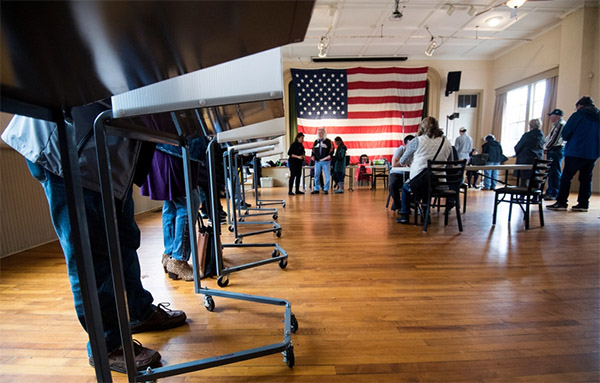Independent voters determine the outcome of most elections at every level

David Winstead, writing at RollCall.com reports:
A few weeks ago, I suggested in this column that independent voters would decide when Joe Biden’s honeymoon is over. Well, Independents’ Day has arrived.
While the president’s support from his Democratic base remains strong enough to offset Republican opposition, several recent polls have seen his job approval rating begin to slip with the most crucial voter group — independents. Our July 6-8 Winning the Issues survey saw Biden’s job approval underwater, with 40 percent of independents approving the job he is doing and 47 percent disapproving. Only a month before, our June survey had him at 46 percent approve/42 percent disapprove, a significant drop.
If this negative trend with independents continues, Democrats could face strong headwinds in 2022 as they try to maintain their slim majorities in both the House and Senate. The White House and congressional Democrats have focused on Biden’s overall job approval numbers to bolster their case that the president and his progressive policies are popular with the public.
They’re right that Biden remains just above 50 percent in most polls, a function of his Democratic base support. Republicans, for the most part, were never with him. What they aren’t talking about, however, is what appears to be Democrats’ looming problem with independents.
With the two party bases locked in a partisan divide, it’s looking like independent voters will be back next year in the catbird seat, as they have been in most elections for decades, with the power to choose the next Congress.
For Democrats trying to paint a rosy picture for 2022, there are some takeaways from the 2020 election, especially about the behavior of independents, that ought to be worrisome indeed for a party with the slimmest of majorities.
First, the overall electorate in 2020 was slightly more Republican and slightly more center-right than in 2016. Exit polls in 2016 showed Democrats with a 3-point advantage in party identification. In 2020, that margin was reduced to a 1-point advantage.
Second, in terms of ideology, self-defined conservatives outnumbered liberals by 9 points in 2016. The advantage for conservatives increased to 14 points in 2020; 15 points at the congressional level.
Finally, a majority of the country is not a part of either party’s base, a trend that is often ignored by policymakers and pundits. In 2016, liberal Democrats were 18 percent of the country, and conservative Republicans were 21 percent (22 percent at the congressional level). Both groups added up to 39 percent, meaning 61 percent of voters were something else.
So, if Republicans improved in party identification, ideology and size of base, why did Donald Trump lose in 2020? The answer — independents, a group Trump won by 4 points in 2016 and lost by 13 points four years later, a seismic shift of 17 points. In fact, you have to go back to Walter Mondale in 1984 to find a major presidential candidate who lost independents by a larger margin than Trump.

This same “independent effect” was seen in the eight key states where the margin between Trump and Biden was less than 4 points: Arizona, Florida, Georgia, Michigan, Nevada, North Carolina, Pennsylvania and Wisconsin. In each, the party ID margin improved for Republicans over 2016. Yet, Trump lost six of these states.
In terms of ideology, the margin of conservatives over liberals also improved in six of the eight. In Georgia, conservatives led liberals by 18 points, and in North Carolina, conservatives did so by 20 points.
In all of these states, Trump’s margins with independents dropped by double digits. In four of the eight, these margins dropped by a staggering 20 points or more: Michigan (-22), Wisconsin (-22) Georgia (-20) and North Carolina (-20).
The reason that Republicans came close but did not win the majority in Congress was not that the country went left, or became more Democratic. It was because enough of the political center that voted on personality at the presidential level (27 percent) moved toward the Democrats. Congressional Republicans lost this group, and that was enough for Democrats to keep the House and win the Senate, if just barely.
But independents have a propensity to change sides. In the last election, independent conservatives outnumbered independent liberals by 14 points (32 percent to 18 percent), with independent moderates accounting for half.
Historically, independents aren’t happy when one party wins everything and then takes a hard ideological turn. In 1994, Republicans won independents by 14 points, after losing them by 8 in 1992 — a flip of 22 points. After taking back the House in 2006 and winning independents by 18 points, Democrats won the trifecta in 2008 and promptly moved hard left. In 2010, Republicans won independents by 19 points, a 37-point switch, so large that Republicans won women that year. In 2018, Democrats won independents by 12 points after losing them by 6 in 2016 — a shift of 18 points.
If there is any lesson to be learned from these elections, it is this: Don’t take independents and their concerns for granted. Barack Obama did that in 2009, focusing on health care instead of unemployment. Trump made the same mistake in 2018, when he made immigrant caravans the issue rather than a growing economy. Both saw their party lose the House in the midterms.
So, the next time you see the media and political partisans selling the idea that elections are “all about the base,” don’t buy it.
Election Day 2022 will be Independents’ Day one more time.
David Winston is the president of The Winston Group and a longtime adviser to congressional Republicans. He previously served as the director of planning for Speaker Newt Gingrich. He advises Fortune 100 companies, foundations, and nonprofit organizations on strategic planning and public policy issues, as well as an election analyst for CBS News.
Comment
|
|
Steven P. Rader said:
( July 18th, 2021 @ 5:43 pm )
This analysis is seriously flawed. Any professional projections look at voting behavior, NOT voter registration. The fact is that a majority of those registered as unaffiliated (independent) are straight ticket voters for one party or the other. Base vote is not determined by registration but by the vote totals of the lowest candidate on each party ticket. What is left are the swing voters. In eastern North Carolina counties, registered unaffiliated voters generally comprise 30 to 40% of registered voters but the true swing vote is often a third of that or less. Also, registered independents are not generally moderates. On most issues, they are overall nearly as conservative as Republicans. Indeed of self described moderates, if one drills down into poll cross tabs, they will find that they are not generally in the middle of the spectrum on issues, but to the contrary, they are conservative on some issues and liberal on others. The key to getting these voters is not to run in the middle but to use polling to determine which of your conservative issues appeal to these voters and tailor your message to them around those issues. The analysis in the main post is not a good political analysis.
|
| The Real Story of January 6 | Editorials, Beaufort Observer, Op-Ed & Politics | Lt. Governor Mark Robinson |





















